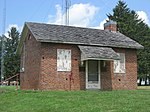Greenville Carnegie Library
1901 establishments in OhioBuildings and structures in Greenville, OhioCarnegie libraries in OhioEducation in Darke County, OhioLibraries on the National Register of Historic Places in Ohio ... and 2 more
Library buildings completed in 1901National Register of Historic Places in Darke County, Ohio

The Greenville Carnegie Library is a historic library on the edge of downtown Greenville, Ohio, United States. A Carnegie library built for the community in the early 20th century, the library and an adjacent school building have been designated a historic site because of their landmark architecture.
Excerpt from the Wikipedia article Greenville Carnegie Library (License: CC BY-SA 3.0, Authors, Images).Greenville Carnegie Library
West 5th Street,
Geographical coordinates (GPS) Address Nearby Places Show on map
Geographical coordinates (GPS)
| Latitude | Longitude |
|---|---|
| N 40.099166666667 ° | E -84.633055555556 ° |
Address
Greenville Public Library
West 5th Street
45331
Ohio, United States
Open on Google Maps











